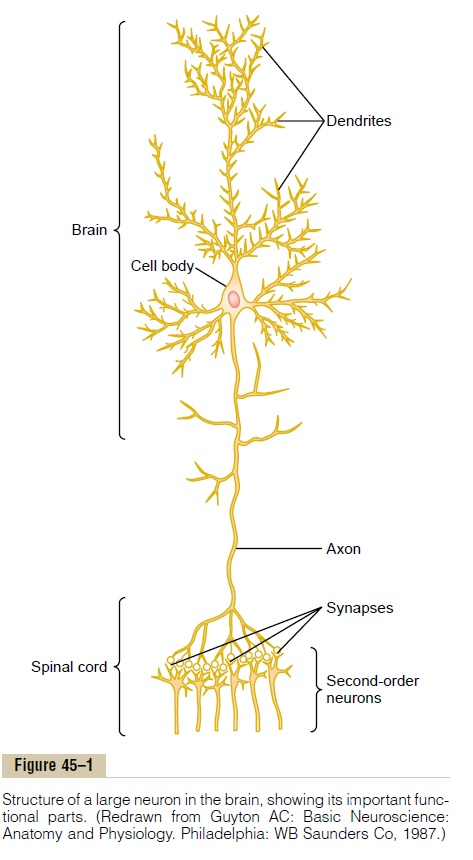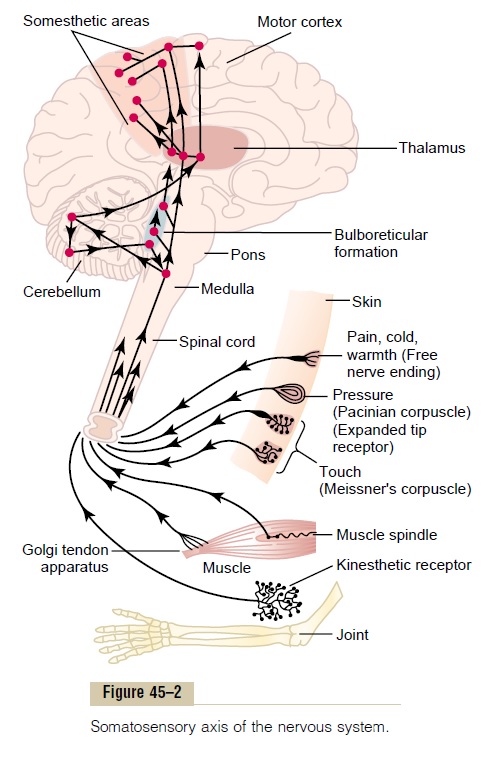Chapter: Medical Physiology: Organization of the Nervous System, Basic Functions of Synapses, “Transmitter Substances”
General Design of the Nervous System
General Design of the Nervous System
Central Nervous System Neuron: The Basic Functional Unit
The central nervous system contains more than 100 billion neurons. Figure 45–1 shows a typical neuron of a type found in the brain motor cortex. Incoming signals enter this neuron through synapses located mostly on the neuronal den-drites, but also on the cell body. For different types of neurons, there may be only a few hundred or as many as 200,000 such synaptic connections from input fibers. Conversely, the output signal travels by way of a single axon leaving the neuron. Then, this axon has many separate branches to other parts of the nervous system or peripheral body.

A special feature of most synapses is that the signal normally passes only in the forward direction (from the axon of a preceding neuron to dendrites on cell membranes of subsequent neurons). This forces the signal to travel in required directions for performing specific nervous functions.
Sensory Part of the Nervous System—Sensory Receptors
Most activities of the nervous system are initiated by sensory experience exciting sensory receptors, whether visual receptors in the eyes, auditory receptors in the ears, tactile receptors on the surface of the body, or other kinds of receptors. This sensory experience can either cause immediate reaction from the brain, or memory of the experience can be stored in the brain for minutes, weeks, or years and determine bodily reactions at some future date.
Figure 45–2 shows the somatic portion of the sensory system, which transmits sensory information from the receptors of the entire body surface and from some deep structures. This information enters the central nervous system through peripheral nerves and is conducted immediately to multiple sensory areas in (1) the spinal cord at all levels; (2) the reticular substance of the medulla, pons, and mesencephalon of the brain; (3) the cerebellum; (4) the thal-amus; and (5) areas of the cerebral cortex.

Motor Part of the Nervous System— Effectors
The most important eventual role of the nervous system is to control the various bodily activities. This is achieved by controlling (1) contraction of appropri-ate skeletal muscles throughout the body, (2) contrac-tion of smooth muscle in the internal organs, and (3) secretion of active chemical substances by both exocrine and endocrine glands in many parts of the body. These activities are collectively called motorfunctions of the nervous system, and the muscles andglands are called effectors because they are the actual anatomical structures that perform the functions dic-tated by the nerve signals.
Figure 45–3 shows the “skeletal” motor nerve axis of the nervous system for controlling skeletal muscle con-traction. Operating parallel to this axis is another system, called the autonomic nervous system, for controlling smooth muscles, glands, and other internal bodily systems;

Note in Figure 45–3 that the skeletal muscles can be controlled from many levels of the central nervous system, including (1) the spinal cord; (2) the reticular substance of the medulla, pons, and mesencephalon; (3) the basal ganglia; (4) the cerebellum; and (5) the motor cortex. Each of these areas plays its own spe-cific role, the lower regions concerned primarily with automatic, instantaneous muscle responses to sensory stimuli, and the higher regions with deliberate complex muscle movements controlled by the thought processes of the brain.
Processing of Information— “Integrative” Function of the Nervous System
One of the most important functions of the nervous system is to process incoming information in such a way that appropriate mental and motor responses will occur. More than 99 per cent of all sensory informa-tion is discarded by the brain as irrelevant and unim-portant. For instance, one is ordinarily unaware of the parts of the body that are in contact with clothing, as well as of the seat pressure when sitting. Likewise, attention is drawn only to an occasional object in one’s field of vision, and even the perpetual noise of our sur-roundings is usually relegated to the subconscious.
But, when important sensory information excites the mind, it is immediately channeled into proper inte-grative and motor regions of the brain to cause desired responses. This channeling and processing of informa-tion is called the integrative function of the nervous system. Thus, if a person places a hand on a hot stove, the desired instantaneous response is to lift the hand. And other associated responses follow, such as moving the entire body away from the stove, and perhaps even shouting with pain.
Role of Synapses in Processing Information. The synapseis the junction point from one neuron to the next. Later, we will discuss the details of synaptic function. However, it is important to point out here that synapses determine the directions that the nervous signals will spread through the nervous system. Some synapses transmit signals from one neuron to the next with ease, whereas others transmit signals only with difficulty. Also, facilitatory and inhibitory signals from other areas in the nervous system can control synaptic transmission, sometimes opening the synapses for transmission and at other times closing them. In addition, some postsynaptic neurons respond with large numbers of output impulses, and others respond with only a few. Thus, the synapses perform a selective action, often blocking weak signals while allowing strong signals to pass, but at other times selecting and amplifying certain weak signals, and often channeling these signals in many directions rather than only one direction.
Storage of Information—Memory
Only a small fraction of even the most important sensory information usually causes immediate motor response. But much of the information is stored for future control of motor activities and for use in the thinking processes. Most storage occurs in the cerebral cortex, but even the basal regions of thebrain and the spinal cord can store small amounts of information.
The storage of information is the process we call memory, and this, too, is a function of the synapses.That is, each time certain types of sensory signals pass through sequences of synapses, these synapses become more capable of transmitting the same type of signal the next time, a process called facilitation. After the sensory signals have passed through the synapses a large number of times, the synapses become so facili-tated that signals generated within the brain itself can also cause transmission of impulses through the same sequences of synapses, even when the sensory input is not excited. This gives the person a perception of expe-riencing the original sensations, although the percep-tions are only memories of the sensations.
We know little about the precise mechanisms by which long-term facilitation of synapses occurs in the memory process.
Once memories have been stored in the nervous system, they become part of the brain processing mechanism for future “thinking.” That is, the thinking processes of the brain compare new sensory experi-ences with stored memories; the memories then help to select the important new sensory information and to channel this into appropriate memory storage areas for future use or into motor areas to cause immediate bodily responses.
Related Topics